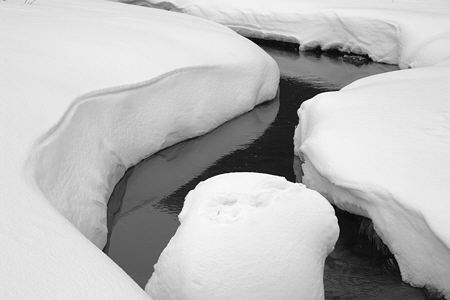
Natural black and white minimalism as well. To a certain extent, photographers choose (or are chosen by) their style when they choose their subject. Of course, the way of framing the subject plays an essential role. But in landscape photographs larger than minute details, it’s hard to find an uncluttered field of view. Winter simplifies.
Since I seem to have a natural inclination toward abstraction, you can well imagine I was delighted to find these snow forms in the wandering branches where the young Gallatin River is still figuring out where it belongs. I was also delighted to be on a pair of broad back country skis, a rental substitute for my 15-year old kit that had finally broken multiple places in every component, to the point it really was not usable even by an anti-gear guy like myself. The new skis allowed me to move easily along and among these streams, despite the deep, soft snow. I would gladly have spent all day there, had I been free.
These images are very new, and I haven’t yet worked out quite how I will handle them. I actually made precursors to these a year or two ago, but somehow couldn’t figure out what I wanted from them. I’m still exploring that, but this time I have the feeling that I will be able to make a set that I’ll find worth printing. In most the snow dominates, though in some the dark, dark water is a large fraction of the picture area. I want to show enough detail in both (for intrinsic and pictorial interest, and also to keep a sense of reality), but still maintain the tonal separation that emphasizes the abstract shapes.
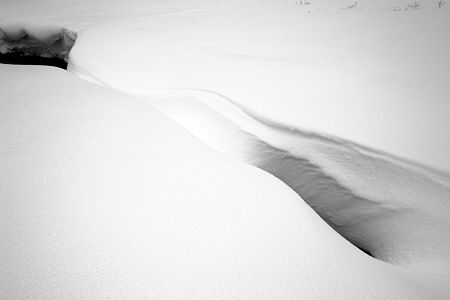
One thing I’m debating is how to handle the twigs of bushes sticking up through the snow. I made a few photographs where these play a major compositional role (sorry, not processed yet…), but in ones like that above, I could either crop out or clone out the stray bits. What do you think? Though far from the center of attention, I wonder if they add a useful counterweight, and also a reminder that this is indeed a reasonably faithful record of a real scene (if that matters — does it?).
Another undecided is the observable darkening toward the sides, due to the physical fall-off of optical intensity away from the axis of the lens. It’s normally not seen, but increasing the contrast in the lighter tones to bring out the snow shapes, together with the relatively featureless surface, makes it noticeable. Would it be best to remove it, in your opinion?
Update: Here are three more I had a chance to process provisionally. The last has a slight tint.
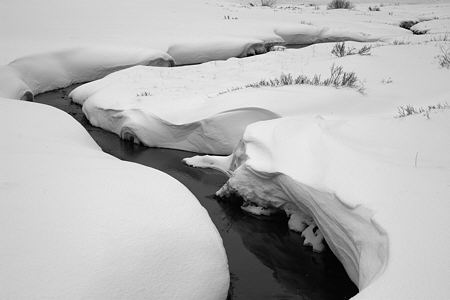
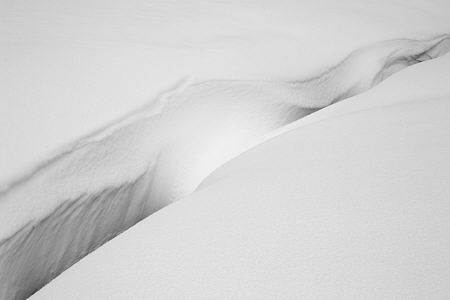
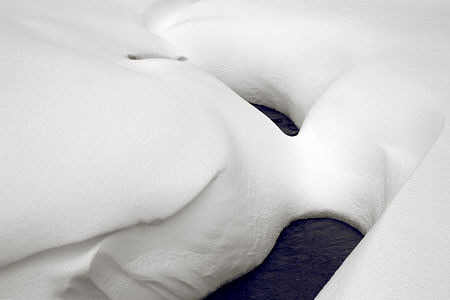

Steve,
At the risk of revealing my ignorance and insufficiently educated taste in photography, may I say that the last photo is perfect. In particular, the bits of twigs, I think, are a fine counter to the flow of the rest. About the light, I’m not so sure, but I have always loved what snow and wind can produce in the way of finite eternity — and you’ve captured it. Sorry to be so uncritical.
Both images are stunning to me as shown.
They inspire me to head out to recover from having spent a long day in a room without a window.
Steve,
Maybe, I am trying too hard to relearn my anatomy or perhaps, I have looked at too many of Jacob Collins nudes, but my first impression of picture two was anthropomorphic – buttocks.
I do like the lighting introduced by lens imperfections. It mimics the way painters highlight things.
Birgit,
The tendency to see anthropomorphic forms is almost irresistible. The more I learn about brain development (including perception), the more I believe social interactions were a major driving force for that development. We’re all looking for someone to groom (or perhaps to groom us).
Steve,
I am still blown away by these photographs. They are exquisite.
Like Birgit, I think the slight fall off in light at the edges enhances the rounded shapes that you are investigating. The shadows continue the experience of tangible roundness, like clouds you could fall into and that show their shapes solely through light and dark.
The pristine surfaces are tantalizing, like the edge of a cliff tantalizes. One wants to mess them up (or jump off the cliff) at the same time that one wants to possess them as is, which is of course impossible. Maybe it’s the impossibility of owning or retaining or interacting with the shapes that is so stunning. I’m accustomed to control, but here, there’s the absolute “If you touch it, you no longer have it.” But I also have the knowledge that the snow like this will disappear anyway. And yet these images are left behind, caught by the sensitive eye of the photographer. Miraculous.
I would like to be able to paint these, but I doubt that I could. I wonder if any painter has managed to do so.
I liked your phrase: “the young Gallatin River is still figuring out where it belongs” and thought I’d be seeing something related to that, but these are old forms, ancient forms, enduring forms, forms that are both enticing and fragile. And also in some sense eternal, there whether seen or not, simply a part of the rhythms of the earth which go on with or without us. They are like the art of the Tibetans monks, which takes weeks to assemble out of colored sand — and then gets scattered. I always had the feeling that if I breathed too hard, the sand would blow into incoherence. I am holding my breath looking at these photos, too.
June,
How do I blush on the Internet?
You bring up a great point about the relative transience of these forms, and that’s especially interesting as a contrast to their apparent massive solidity. Those largish shapes were part of the attraction, and they’re more interesting as emphasized above a small branch stream than they are along the main river.
As for touching or interacting: I do have one photograph in which the jagged edge (as opposed to these mostly rounded ones) is the result of a fracture caused by my too close approach. And at the center of the rock in the first image, a bird has been hopping about (hard to identify, but note the lack of tracks on either bank). Another features a coyote (or fox?) trail, though it’s not so successful otherwise.
Steve:
I, my aching back and beleaguered car are here to tell you that these images are not at all amusing. It’s all melting into the usual accumulation of brown and stranded heaps and the streets are awash. Spring cannot come too soon. But I must admit that a few nights ago it was a fairyland of glitter and snow, fashioned in the spirit of Dr.Seuss.
I agree with June: the second image is remarkable. The other images are clear about the relationship of river to snow, but number two is all subtlety and inference. One thing that you may have already mentioned is the glow in the center of more than one image that reminds me, for some reason, of the old classic, The Day The Earth Stood Still. It’s an unearthly kind of glow and I’m a little ambivalent about it.
It’s a matter of how I frame my thoughts concerning the grass poking through the snow. On the one hand it takes me to another time of year, perhaps, and the image assumes the shape of a narrative. That’s good and the image works in that reference. However, if I’ve grown attached to the purity of snow and flow as seen in the others, it then can be a little scratchy: as though one of your lovely horses may be standing expectantly off to a side.